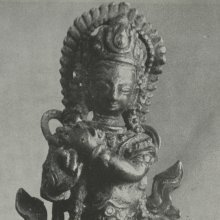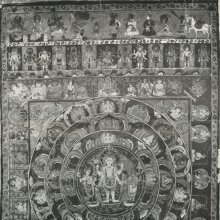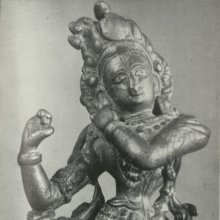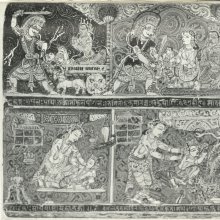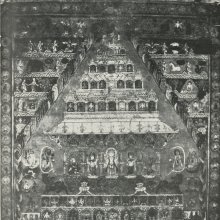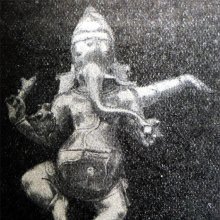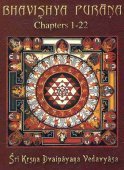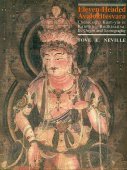Bombay: 3 definitions
Introduction:
Bombay means something in the history of ancient India. If you want to know the exact meaning, history, etymology or English translation of this term then check out the descriptions on this page. Add your comment or reference to a book if you want to contribute to this summary article.
Images (photo gallery)
(+3 more images available)
India history and geography
Source: What is India: Annual Report on Indian Epigraphy (1945-1952)Bombay is an archaeologically important site situated in the Bombay district, known for inscriptions regarding the ancient history of India. For example, at the Prince of Wales Museum, there is a slab which records the construction of the shrines of Śāntinātha, Pārśvanātha and Supārśvanātha at Ponnavāḍa by Chāṅkirāja of the Vāṇasa family, an officer of the Chālukya queen Ketaladevī and registers grants of lands to these temples by the king at the request of the queen.
This inscription belongs to king Trailokyamalladeva of the Western Chālukya dynasty and is dated Śaka 976 (1054 A.D.)
Another inscription refers to the construction of a shrine at Gerasoppe by the chief Sāluva Nāyaka, son of Hemmarasi-Nāyikiti and Viṭṭhappa-Nāyaka, and to the consecration of Śānti-Tīrthaṅkara therein and records gifts of lands made to the same by the chief.
This inscription belongs to king Sāluva Nāyaka of the Western Sāluvas of Saṅgītapura and is dated Śaka 1485 (1562 A.D.).
Source: Marathi language (Marāṭhī bhāṣā): Submission for Classical Status of Marathi LanguageBombay is the name of a district in Maharashtra.—The Buddhist work, Mahavamsa, refers to Maharashtra. It suggests that a big area around Ujjain, that is, the present Central India could have been talked about as Maharashtra. As the legend goes there were (or might have been) 99,000 villages in this country. These days it is a practice to include all areas (Bombay) where Marathi language is in use into Maharashtra.

The history of India traces the identification of countries, villages, towns and other regions of India, as well as mythology, zoology, royal dynasties, rulers, tribes, local festivities and traditions and regional languages. Ancient India enjoyed religious freedom and encourages the path of Dharma, a concept common to Buddhism, Hinduism, and Jainism.
Languages of India and abroad
Nepali dictionary
Source: unoes: Nepali-English DictionaryBombay is another spelling for बम्बई [bambaī].—n. Bombay (also Mumbai); one of the major cities of India;
Nepali is the primary language of the Nepalese people counting almost 20 million native speakers. The country of Nepal is situated in the Himalaya mountain range to the north of India.
See also (Relevant definitions)
Starts with: Bombay aloe, Bombay atalantia, Bombay blackwood, Bombay cowpea, Bombay hemp, Bombay mastic, Bombay rosewood, Bombay senna, Bombay-aanp, Bombaya.
Ends with: Bawang bombay, Bdellium of bombay.
Full-text (+7155): Samyatalavisharada, Konkana, Shurparaka, Pratisamyukta, Bambai-ampa, Kavalayati, Sphic, Bombay-aanp, Bombay senna, Bombay blackwood, Bawang bombay, Dhatreyi, Dhatreyika, Bombay rosewood, Bombay atalantia, Nyayasamkshepa, Bombay mastic, Kalanchoe bhidei, Bdellium of bombay, Kanyas.
Relevant text
Search found 126 books and stories containing Bombay; (plurals include: Bombaies). You can also click to the full overview containing English textual excerpts. Below are direct links for the most relevant articles:
Srila Gurudeva (The Supreme Treasure) (by Swami Bhaktivedanta Madhava Maharaja)
Juhu Bombay: Tamāla Kṛṣṇa Mahārāja Takes Lessons < [Chapter 2.13 - Śrīla Gurudeva Testifies to Save ISKCON]
ISKCON Leaders in Mathurā < [Chapter 2.13 - Śrīla Gurudeva Testifies to Save ISKCON]
Introduction—proceedings against ISKCON < [Chapter 2.13 - Śrīla Gurudeva Testifies to Save ISKCON]
The Markandeya Purana (by Frederick Eden Pargiter)
Literature for Children (A Review of Books) < [January 1959]
The Two Faces of God < [October - December 1977]
Nissim Ezekiel’s “Bombay Poems” < [July – September, 1990]
A study of the philosophy of Jainism (by Deepa Baruah)
Mahabharata (English) (by Kisari Mohan Ganguli)
Section LXXXI < [Bhagavat-Gita Parva]
Section XXII < [Bhagavat-Gita Parva]
Section VI < [Jambukhanda Nirmana Parva]
Lord Jhulelal: An Analytical Study (by Thakkar Harish Gopalji)
Part 23 - Bhatia People < [Chapter 2 - Literature Review]
Part 20 - Lohana People < [Chapter 2 - Literature Review]
Part 3 - Miracles < [Chapter 4 - Analysis]
Related products
